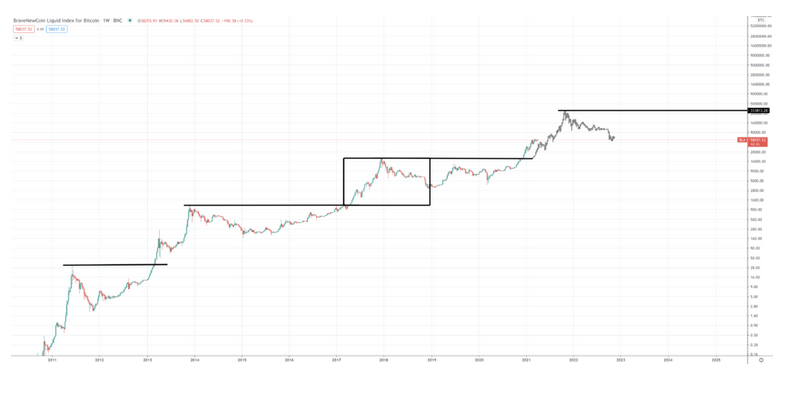Bitcoin 2022 Prediction: A Retrospective Analysis of Forecasts and Market Realities
Remember those Bitcoin 2022 predictions? We break down what went right, what went wrong, and why the crypto market took a wild ride. Get the real story!

The year 2022 proved to be a tumultuous one for the cryptocurrency market, and the Bitcoin 2022 prediction landscape was littered with both optimistic hopes and dire warnings. Many analysts, riding the wave of 2021’s bullish performance, projected continued growth, while others foresaw the potential for correction. However, few accurately predicted the full extent of the market downturn that ultimately unfolded, driven by macroeconomic factors, regulatory uncertainty, and high-profile collapses within the crypto ecosystem. The Bitcoin 2022 prediction cycle became a lesson in the inherent volatility and unpredictability of this emerging asset class.
Analyzing the Missed Marks
Several factors contributed to the inaccurate predictions that dominated the 2022 narrative. Understanding these factors is crucial for refining future forecasts and managing expectations within the cryptocurrency space.
- Ignoring Macroeconomic Headwinds: Many predictions failed to adequately account for rising inflation, interest rate hikes by central banks, and the overall economic slowdown impacting global markets. These factors significantly reduced investor appetite for risk assets, including Bitcoin.
- Underestimating Regulatory Impact: Increased scrutiny from regulatory bodies worldwide created uncertainty and dampened investor enthusiasm. The lack of clear and consistent regulations continues to be a significant obstacle for the crypto market.
- Black Swan Events: The collapse of Terra/Luna and FTX sent shockwaves through the industry, triggering cascading liquidations and eroding investor confidence. These events were largely unforeseen and contributed significantly to the market downturn.
The Rise and Fall: Key Events of 2022
2022 was a year of dramatic highs and devastating lows for Bitcoin. Let’s examine some key moments:
- Early Optimism: The year began with lingering optimism from Bitcoin’s 2021 performance, fueling predictions of continued growth.
- The Terra/Luna Crash: The collapse of the algorithmic stablecoin TerraUSD (UST) and its sister token Luna in May sent the market into a tailspin.
- Inflation and Interest Rate Hikes: Central banks aggressively raised interest rates to combat inflation, putting downward pressure on risk assets.
- The FTX Debacle: The bankruptcy of FTX, one of the world’s largest cryptocurrency exchanges, further eroded investor confidence and triggered widespread liquidations.
Lessons Learned and Future Outlook
The experience of 2022 provides valuable lessons for investors and analysts alike. While predicting the future of any asset is inherently challenging, a more nuanced approach that considers macroeconomic factors, regulatory developments, and the inherent risks within the crypto ecosystem is essential.
Applying a Holistic Approach
Moving forward, it’s crucial to incorporate a wider range of data points and perspectives when formulating forecasts. Consider the following:
- Macroeconomic Analysis: Closely monitor inflation rates, interest rate policies, and overall economic growth trends.
- Regulatory Landscape: Stay informed about regulatory developments in key jurisdictions and their potential impact on the market.
- On-Chain Metrics: Analyze on-chain data, such as transaction volume, active addresses, and whale activity, to gain insights into market sentiment.
- Risk Management: Implement robust risk management strategies to protect against potential losses.
Ultimately, predicting the future of Bitcoin, or any cryptocurrency, with certainty is impossible. However, by learning from the mistakes of the past and adopting a more comprehensive and cautious approach, investors and analysts can better navigate the volatile world of digital assets. The importance of understanding market cycles and being prepared for unexpected events is paramount. As we move forward, it’s clear that any future Bitcoin 2022 prediction analysis must acknowledge and incorporate the lessons learned from this challenging year.
THE ENDURING APPEAL OF BITCOIN
Despite the setbacks experienced in 2022, Bitcoin’s underlying value proposition remains compelling to many. Its decentralized nature, limited supply, and potential as a store of value continue to attract investors seeking an alternative to traditional financial systems. The technology continues to evolve, with advancements like the Lightning Network offering solutions to scalability challenges and increased transaction speeds.
COMPARISON TABLE: BITCOIN VS. TRADITIONAL ASSETS
Asset
Decentralization
Supply
Volatility
Regulation
Bitcoin
Decentralized
Limited (21 million)
High
Evolving
Traditional Fiat Currencies
Centralized
Unlimited (can be printed)
Relatively Low
Heavily Regulated
Gold
Decentralized (to a degree)
Limited (but unknown)
Moderate
Regulated
This table highlights some key differences between Bitcoin and traditional assets. While Bitcoin offers decentralization and a limited supply, it also comes with higher volatility and a less defined regulatory framework. The suitability of Bitcoin as an investment depends on an individual’s risk tolerance and investment goals.
BEYOND PRICE PREDICTIONS: FOCUSING ON FUNDAMENTALS
Instead of solely focusing on price predictions, a more productive approach is to focus on the fundamentals of Bitcoin and the broader cryptocurrency ecosystem. This includes understanding the underlying technology, the network’s security, the adoption rate, and the regulatory environment. By focusing on these factors, investors can make more informed decisions and navigate the market with greater confidence.
Looking back, the lessons learned from the Bitcoin 2022 prediction failures are invaluable. The crypto world is in constant flux, and a nimble, informed approach is crucial for success.




